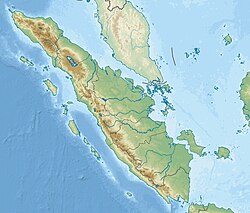Top Qs
Timeline
Chat
Perspective
Musi River (Indonesia)
River in Sumatra, Indonesia From Wikipedia, the free encyclopedia
Remove ads
The Musi River (Indonesian: Sungai Musi) is a river in Southern Sumatra, Indonesia.[8] It flows from south-west to north-east, from the Barisan Mountains range that form the backbone of Sumatra, in Kepahiang Regency, Bengkulu Province, to the Bangka Strait that forms an extension of the South China Sea. The Musi is about 750 kilometers long, and drains most of South Sumatra province. After flowing through Palembang, the provincial capital, it joins with several other rivers, including the Banyuasin River, to form a delta near the town of Sungsang. The river, dredged to a depth of about 8 meters,[5] is navigable by large ships as far as Palembang, which is the site of major port facilities used primarily for the export of petroleum, rubber and palm oil.
Remove ads
This river system, especially around the city of Palembang, was the heart of eponymous 7th to 13th century Srivijayan empire. The river mouth was the site of the SilkAir Flight 185 plane crash which killed all 104 passengers and crew on board in 1997.[9]
Remove ads
Geography
The river flows in the southern area of Sumatra, which has a predominantly tropical rainforest climate (designated as Af in the Köppen-Geiger climate classification).[10] The annual average temperature in the area is 24 °C. The warmest month is July, when the average temperature is around 26 °C, and the coldest is February, at 22 °C.[11] The average annual rainfall is 2579 mm. The wettest month is April, with an average of 344 mm rainfall, and the driest is September, with 99 mm of rain.[12]
Remove ads
Tributaries
The main tributaries from the mouth:[1]
Remove ads
Gallery
- The Musi River and Palembang
- The Musi River by Palembang
- The Ampera Bridge on Musi River, Palembang
- watershed of the Musi River
See also
References
External links
Wikiwand - on
Seamless Wikipedia browsing. On steroids.
Remove ads







